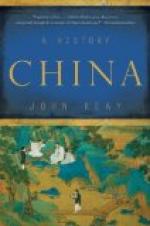In the meantime, Mao Tse-tung had given up his studies in Peking and had returned to his home in Hunan. Here, he organized his countrymen, the farmers of Hunan. It is said that at the verge of the northern expedition of Chiang Kai-shek, Mao’s adherents in Hunan already numbered in the millions; this made the quick and smooth advance of the communist-advised armies of Chiang Kai-shek possible. Mao developed his ideas in written form in 1927; he showed that communism in China could be successful only if it was based upon farmers. Because of this unorthodox attitude, he was for years severely attacked as a deviationist.
When Chiang Kai-shek separated from the KMT in 1927, the main body of the KMT remained in Hankow as the legal government. But now, while Chiang Kai-shek executed all leftists, union leaders, and communists who fell into his hands, tensions in Hankow increased between the Chinese Communist Party and the rest of the KMT. Finally, the KMT turned against the communists and reunited with Chiang Kai-shek. The remaining communists retreated to the Hunan-Kiangsi border area, the centre of Mao’s activities; even the orthodox communist wing, which had condemned Mao, now had to come to him for protection from the KMT. A small communist state began to develop in Kiangsi, in spite of pressure and, later, attacks of the KMT against them. By 1934, this pressure became so strong that Kiangsi had to be abandoned, and in the epic “Long March” the rest of the communists and their army fought their way through all of western and north-western China into the sparsely inhabited, underdeveloped northern part of Shensi, where a new socialistic state was created with Yen-an as its capital.
After the fall of the communist enclave in Kiangsi, the prospects for the Nationalist regime were bright; indeed, the unification of China was almost achieved. At this moment a new Japanese invasion threatened and demanded the full attention of the regime. Thus, in spite of talk about land reform and other reforms which might have led to a liberalization of the government, no attention was given to internal and social problems except to the suppression of communist thought. Although all leftist publications were prohibited, most historians and sociologists succeeded in writing Marxist books without using Marxist terminology, so that they escaped Chiang’s censors. These publications contributed greatly to preparing China’s intellectuals and youth for communism.
When the Japanese War began, the communists in Yen-an and the Nationalists under Chiang Kai-shek agreed to co-operate against the invaders. Yet, each side remembered its experiences in 1927 and distrusted the other. Chiang’s resistance against the invaders became less effective after the Japanese occupied all of China’s ports; supplies could reach China only in small quantities by airlift or via the Burma Road. There was also the belief that Japan could be defeated only by an attack on




